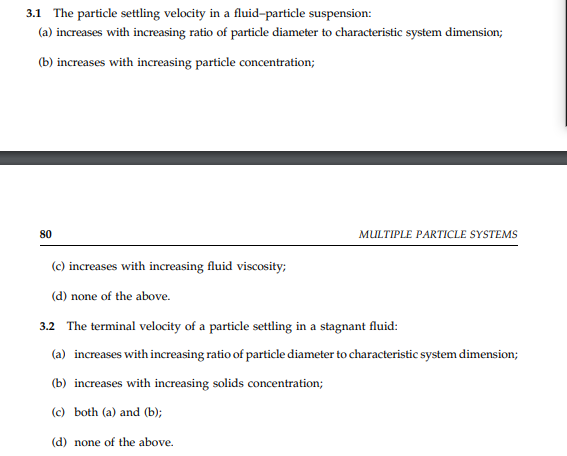The particle settling velocity in a fluid-particle suspension: a) increases with increasing ratio of particle diameter to characteristic system dimension; b) increases with increasing particle concentration; 80 MULTIPLE PARTICLE SYSTEMS (c) increases with increasing fluid viscosity; (d) none of the above. 3.2 The terminal velocity of a particle settling in a stagnant fluid: (a) increases with increasing ratio of particle diameter to characteristic system dimension; (b) increases with increasing solids concentration; (c) both (a) and (b); d) none of the aboue
The particle settling velocity in a fluid-particle suspension: a) increases with increasing ratio of particle diameter to characteristic system dimension; b) increases with increasing particle concentration; 80 MULTIPLE PARTICLE SYSTEMS (c) increases with increasing fluid viscosity; (d) none of the above. 3.2 The terminal velocity of a particle settling in a stagnant fluid: (a) increases with increasing ratio of particle diameter to characteristic system dimension; (b) increases with increasing solids concentration; (c) both (a) and (b); d) none of the aboue
Introduction to Chemical Engineering Thermodynamics
8th Edition
ISBN:9781259696527
Author:J.M. Smith Termodinamica en ingenieria quimica, Hendrick C Van Ness, Michael Abbott, Mark Swihart
Publisher:J.M. Smith Termodinamica en ingenieria quimica, Hendrick C Van Ness, Michael Abbott, Mark Swihart
Chapter1: Introduction
Section: Chapter Questions
Problem 1.1P
Related questions
Question

Transcribed Image Text:3.1 The particle settling velocity in a fluid-particle suspension:
(a) increases with increasing ratio of particle diameter to characteristic system dimension;
(b) increases with increasing particle concentration;
80
MULTIPLE PARTICLE SYSTEMS
(c) increases with increasing fluid viscosity;
(d) none of the above.
3.2 The terminal velocity of a particle settling in a stagnant fluid:
(a) increases with increasing ratio of particle diameter to characteristic system dimension;
(b) increases with increasing solids concentration;
(c) both (a) and (b);
(d) none of the above.
Expert Solution
This question has been solved!
Explore an expertly crafted, step-by-step solution for a thorough understanding of key concepts.
Step by step
Solved in 3 steps

Recommended textbooks for you

Introduction to Chemical Engineering Thermodynami…
Chemical Engineering
ISBN:
9781259696527
Author:
J.M. Smith Termodinamica en ingenieria quimica, Hendrick C Van Ness, Michael Abbott, Mark Swihart
Publisher:
McGraw-Hill Education

Elementary Principles of Chemical Processes, Bind…
Chemical Engineering
ISBN:
9781118431221
Author:
Richard M. Felder, Ronald W. Rousseau, Lisa G. Bullard
Publisher:
WILEY

Elements of Chemical Reaction Engineering (5th Ed…
Chemical Engineering
ISBN:
9780133887518
Author:
H. Scott Fogler
Publisher:
Prentice Hall

Introduction to Chemical Engineering Thermodynami…
Chemical Engineering
ISBN:
9781259696527
Author:
J.M. Smith Termodinamica en ingenieria quimica, Hendrick C Van Ness, Michael Abbott, Mark Swihart
Publisher:
McGraw-Hill Education

Elementary Principles of Chemical Processes, Bind…
Chemical Engineering
ISBN:
9781118431221
Author:
Richard M. Felder, Ronald W. Rousseau, Lisa G. Bullard
Publisher:
WILEY

Elements of Chemical Reaction Engineering (5th Ed…
Chemical Engineering
ISBN:
9780133887518
Author:
H. Scott Fogler
Publisher:
Prentice Hall


Industrial Plastics: Theory and Applications
Chemical Engineering
ISBN:
9781285061238
Author:
Lokensgard, Erik
Publisher:
Delmar Cengage Learning

Unit Operations of Chemical Engineering
Chemical Engineering
ISBN:
9780072848236
Author:
Warren McCabe, Julian C. Smith, Peter Harriott
Publisher:
McGraw-Hill Companies, The